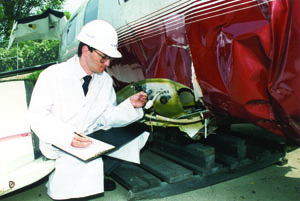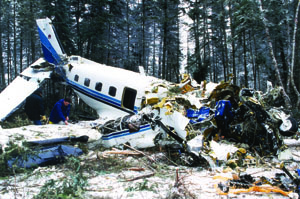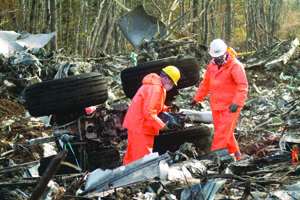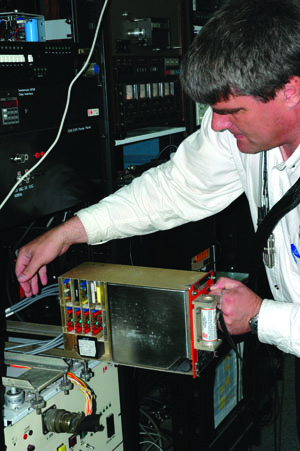
Features
Safety
The Transportation Safety Board
Taking centre stage to advance aviation safety.
September 15, 2008 By Blair Watson
 |
| Independent of other federal agencies and departments such as Transport Canada, the TSB reports to Parliament through the president of the Queen’s Privy Council for Canada. |
Every day nearly a dozen transportation accidents and incidents are reported to the Transportation Safety Board of Canada (TSB). This unique federal organization has the mandate to advance safety in the marine, pipeline, rail and air modes of transportation. The history of the TSB and its activities related to aviation are the focus of this article.
The TSB takes centre stage in the public’s awareness after an aircraft accident. Video of investigators combing through wreckage and comments by a lead TSB member about the accident and investigation are broadcast on major news networks. Also, the popular television program aired on Discovery Channel’s ‘Mayday’ has helped Canadians better understand the work of aircraft accident investigators.
Some of the more prominent aircraft disasters investigated by the TSB during the past 18 years include the August 2/05 runway overrun and crash and fire of Air France Flight 358 at Toronto International Airport, the October 14/04 crash of MK Airlines Flight 1602 at Halifax International Airport, and the crash of Swissair Flight 111 off the coast near Peggy’s Cove, N.S. on September 2/98.
Occurrences involving small to large aircraft and less frequently, air traffic control mistakes, keep TSB air sector personnel busy.

|
| A positive trend over the past decade has been a decrease in the rate of Canadian-registered aircraft accidents per 100,00 hours of operation. |
The TSB was formed in part due to criticism of the federal government’s handling of the investigation into the crash of Arrow Air Flight 1285 on December 12, 1985 through the responsible agency at the time, the Canadian Aviation Safety Board (CASB). AAF1285 was an international charter flight that had arrived from Cairo and was departing Gander for Fort Campbell, Ky. On board the DC-8 were 256 crew and passengers; most of the latter were members of the U.S. Army’s 101 Airborne Division. All occupants died in the crash and subsequent fire, making it the worst air disaster in terms of fatalities to occur in Canada.
Five of the nine CASB members concluded that the probable cause of the crash was ice contamination on the leading edge of the wings. The other four dissented, issuing their opinion that stated, “An in-flight fire … may have resulted from detonations of undetermined origin brought about catastrophic system failures.” A 1989 review by former Supreme Court of Canada Judge Willard Estey ruled that the available evidence did not support ice on the wings as being a cause, let alone a probable cause, of the disaster. Because these events undermined Canadians’ confidence in federal civilian aircraft investigation, the Mulroney government addressed the situation by creating the TSB.
The Canadian Transportation Investigation and Safety Board Act, which came into law on March 29, 1990 provides the legal framework governing TSB activities. Independent of other federal agencies and departments such as Transport Canada, the TSB reports to Parliament through the president of the Queen’s Privy Council for Canada. The agency’s independence not only allows it to be objective in determining causes and contributing factors of transportation occurrences and making safety recommendations, it also instills confidence in the public concerning the investigation process.

|
| In the past five fiscal years, the TSB Air Sector started and completed 238 and 266 investigations respectively, with an average completed investigation duration of 485 days. |
The board consists of five members: Wendy Tadros, R. Henry Wright, Jonathan Seymour, James Walsh and Kathy Fox. Tadros, a lawyer with extensive experience in the transportation sector, was appointed chair in August 2006 after serving as an appointed member for a decade. Fox is the board member with an aviation background, which dates back to 1974 when she began training with Transport Canada as an air traffic controller. In addition to her ATC experience, Fox worked in management positions at Transport Canada and later at Nav Canada, holds an airline transport pilot licence, has flown more than 4,000 hours, and still flies part-time as an instructor and pilot examiner.
The TSB has a staff of about 220 employees, a head office in Gatineau, Que., and regional offices with Air Sector investigators in Dartmouth, N.S.; Dorval, Que.; Richmond Hill, Ont.; Winnipeg; Edmonton; and Richmond, B.C. The agency’s engineering laboratory is in Gloucester, Ont.
The TSB cooperates with Transport Canada, the RCMP, Canadian Coast Guard, Department of National Defence (DND) and National Energy Board (NEB) as necessary to meet its mandate to investigate transportation occurrences, identify safety deficiencies, and make recommendations. With the exception of the RCMP and DND, no federal department other than the TSB can investigate an accident for the purpose of establishing causal and contributory factor findings. Transport Canada and the NEB may investigate for other purposes such as regulatory infractions.
 |
| With the exception of the RCMP and DND, no federal department other than the TSB can investigate an accident for the purpose of establishing causal and contributory factor findings. |
A positive trend over the past decade has been a decrease in the rate of Canadian-registered aircraft accidents per 100,000 hours of operation (10.1 in 1997 down to 6.2 in 2006, the last year of statistics on the TSB website as of this writing). Two years ago, flying activity in Canada was estimated to be 4,161,000 hours, with 262 reported accidents involving aircraft (except ultralights). The average annual number of accidents between 2001 and 2005 was 275.
In the past five fiscal years, the TSB Air Sector started and completed 238 and 266 investigations respectively, with an average completed investigation duration of 485 days. During the same period, the TSB issued 31 recommendations, 54 safety advisories and 37 safety information letters.
The largest TSB investigation to date occurred after the crash of Swissair Flight 111; it lasted 4.5 years and cost $57 million. The McDonnell Douglas MD-11 and its occupants and cargo sustained an impact force “in the order of at least 350 g,” breaking apart into millions of pieces, which made the investigation significantly more difficult. DNA-testing of human remains was required. For weeks after the accident, debris washed ashore and was added to what had already been collected.
After the flight data recorder was recovered from the seabed, TSB investigators discovered that the last five minutes and 37 seconds of the flight were not recorded because the aircrew had turned off the airplane’s electrical power in its attempt to isolate and fight the fire. Reconstructing what happened to SR-111 during its last few minutes was a major challenge for the investigators. More than 350 specialists from the TSB, National Transportation Safety Board (U.S.), Federal Aviation Administration (FAA), Air Accidents Investigation Branch (U.K.), Boeing, Pratt & Whitney, and other organizations such as the Nova Scotia Coroner’s Office were involved.
Part of the laboratory work done by the TSB revealed to the surprise of investigators that the airplane’s thermal insulation blankets, which had passed an FAA test for fire safety, readily ignited. Of the 11 causes and contributing factors of the crash determined by the TSB, the most significant was: “Aircraft certification standards for material flammability were inadequate in that they allowed the use of materials that could be ignited and sustain or propagate fire. Consequently, flammable material propagated a fire that started above the ceiling on the right side of the cockpit near the cockpit rear wall. The fire spread and intensified rapidly to the extent that it degraded aircraft systems and the cockpit environment, and ultimately led to the loss of control of the aircraft.”
The TSB made nine recommendations concerning changes in electrical systems, flight data capture, and aircraft materials (testing, certification, inspection and maintenance). General recommendations were also made for improvements in checklists and fire-detection and fire-fighting equipment and training. The work of aviation investigators and other specialists led to changes in Canada and abroad, principally affecting aircraft wiring and fire hardening. The results of the efforts of TSB personnel after the crash of SR-111 are evidence of how the federal agency meets its mandate to improve transportation safety.